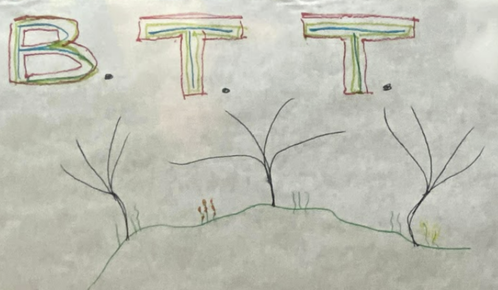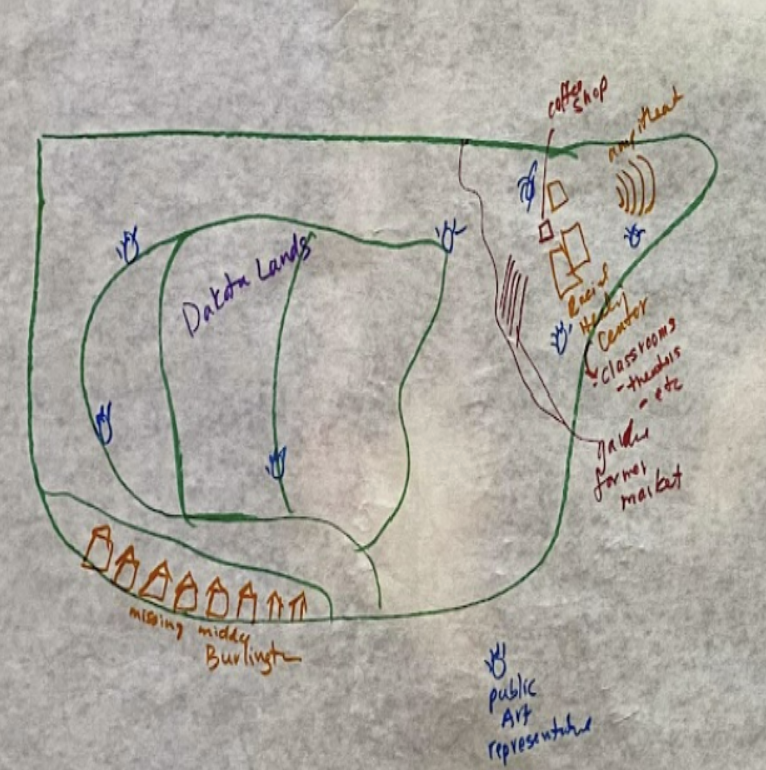Report: Community Dialogue on the BTT Site
|
A Community Dialogue on the Boys Totem Town Site:
A Report Prepared for the Science Museum of Minnesota by Nicole MartinRogers, PhD, MPP last updated 10-22-2022 Click the flag button to translate into Somali, Hmong or Spanish. ** Guji badhanka calanka si aad ugu turjunto Soomaali. ** Nyem lub chij khawm kom txhais ua lus Hmong. ** ¡Haz clic en el botón de la bandera para traducir al español.
|
To print a pdf in your preferred language - click the appropriate link: Soomaali - Hmong - Español - English
Translated using machine translator called "ConveyThis" - apologies for any and all errors.
Translated using machine translator called "ConveyThis" - apologies for any and all errors.
Introduction
A community dialogue was held on August 27, 2022, about the potential uses of and hopes and dreams for Boys Totem Town, which is a 72-acre site in Ramsey County consisting of 10 acres of developed land and roughly 60 acres of undeveloped land including a degraded oak savanna. The site was previously used for over 100 years as a county owned and operated juvenile detention center.
David Valentine, who is a program manager at the Science Museum of Minnesota in the Access and Equity Department and an Association of Science and Technology Centers (ASTC) Science Dialogue & Deliberation Fellow, convened the event, along with Colleen O’Connor Toberman, from Friends of the Mississippi River; Maura Williams, from The Circle of Peace Movement; and Patty McDonald, from the Boys Totem Town Land Preservation Group. This is a group of individuals and organizations who believe in open/green/natural spaces for the good of the community, as well as preserving and interpreting the historically and culturally important spaces at Boys Totem Town.
Importantly, Ramsey County, the owner of the site, did not participate in the planning or convening of this event, nor did they request it. However, this report will be shared with Ramsey County, as well as with key individuals in the city of St. Paul and the state of Minnesota. We hope it will be used by those stakeholders to inform any future plans for the Boys Totem Town site.
A community dialogue was held on August 27, 2022, about the potential uses of and hopes and dreams for Boys Totem Town, which is a 72-acre site in Ramsey County consisting of 10 acres of developed land and roughly 60 acres of undeveloped land including a degraded oak savanna. The site was previously used for over 100 years as a county owned and operated juvenile detention center.
David Valentine, who is a program manager at the Science Museum of Minnesota in the Access and Equity Department and an Association of Science and Technology Centers (ASTC) Science Dialogue & Deliberation Fellow, convened the event, along with Colleen O’Connor Toberman, from Friends of the Mississippi River; Maura Williams, from The Circle of Peace Movement; and Patty McDonald, from the Boys Totem Town Land Preservation Group. This is a group of individuals and organizations who believe in open/green/natural spaces for the good of the community, as well as preserving and interpreting the historically and culturally important spaces at Boys Totem Town.
Importantly, Ramsey County, the owner of the site, did not participate in the planning or convening of this event, nor did they request it. However, this report will be shared with Ramsey County, as well as with key individuals in the city of St. Paul and the state of Minnesota. We hope it will be used by those stakeholders to inform any future plans for the Boys Totem Town site.
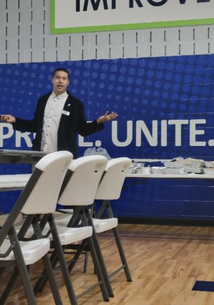
Background
As a part of his ASTC Dialogue & Deliberation Fellowship, David is expected to engage community members in dialogue (to share their perspectives on a topic) and deliberation (to examine options and make actionable decisions) on science-related topics. The purpose of these community engagement activities is to examine societal impacts, community values, and public policy decisions that can inform, and be informed by, science.
A short video was produced by the event organizers to provide a brief history of Boys Totem Town that includes information about the cultural relevance of the site to the Dakota people, the ecological importance of the site as an undisturbed oak savanna, and the history of the site as a juvenile detention facility.
As a part of his ASTC Dialogue & Deliberation Fellowship, David is expected to engage community members in dialogue (to share their perspectives on a topic) and deliberation (to examine options and make actionable decisions) on science-related topics. The purpose of these community engagement activities is to examine societal impacts, community values, and public policy decisions that can inform, and be informed by, science.
A short video was produced by the event organizers to provide a brief history of Boys Totem Town that includes information about the cultural relevance of the site to the Dakota people, the ecological importance of the site as an undisturbed oak savanna, and the history of the site as a juvenile detention facility.
Community engagement approach and session participants
The event was held on August 27, 2022, at Conway Community Center, not far from the BTT site itself. Outreach was conducted in a variety of ways, with an initial focus on reaching marginalized community members including:
After the initial direct outreach, neighborhood newsletters, church groups, and organizational social media outlets were used to broaden attendance.
Roughly 75 people registered for the event. A total of about 45 community members attended the event. While there was noticeable representation from some of the focal groups, the event organizers noted that Hmong and Somali presence was limited. Hmong and Somali translators were on site and ready, but ultimately were not needed by any attendees. The event organizers had also hoped that more individuals who had attended the juvenile detention center would have participated.
The first hour of the event was spent getting participants signed in and having a community meal together. Youth who attended were engaged in fun activities with volunteers. Participants viewed the video about the history of Boys Totem Town and then David reviewed information about the purpose of the event, the fellowship, the context around the event and the lack of County involvement in the event, the possibilities and limitations related to potential development at the Boys Totem Town site, and the considerations of various stakeholders regarding the site. After the video and presentation, attendees participated in facilitated talking circles of 8-10 people, to share their varied perspectives and experiences as well as their hopes, dreams, and concerns about the site. (The talking circles were not recorded or documented and the content of these conversations is not included in this report.)
After the talking circles, attendees participated in several activities designed to gather their input about the Boys Totem Town site, including voting/ranking the possible uses of the site, writing about what they do not want to see at the site and drawing the future they do want to see at the site, comparing and contrasting different possible uses of the site and how well the options would work together, and identifying which community stakeholders should be included in future discussions about the site and how they should be engaged.
The event was held on August 27, 2022, at Conway Community Center, not far from the BTT site itself. Outreach was conducted in a variety of ways, with an initial focus on reaching marginalized community members including:
- Individuals impacted directly by the juvenile detention center, particularly Black and Hmong community members
- Indigenous community members with direct historical ties to the land
- New American (immigrant) communities in the area
After the initial direct outreach, neighborhood newsletters, church groups, and organizational social media outlets were used to broaden attendance.
Roughly 75 people registered for the event. A total of about 45 community members attended the event. While there was noticeable representation from some of the focal groups, the event organizers noted that Hmong and Somali presence was limited. Hmong and Somali translators were on site and ready, but ultimately were not needed by any attendees. The event organizers had also hoped that more individuals who had attended the juvenile detention center would have participated.
The first hour of the event was spent getting participants signed in and having a community meal together. Youth who attended were engaged in fun activities with volunteers. Participants viewed the video about the history of Boys Totem Town and then David reviewed information about the purpose of the event, the fellowship, the context around the event and the lack of County involvement in the event, the possibilities and limitations related to potential development at the Boys Totem Town site, and the considerations of various stakeholders regarding the site. After the video and presentation, attendees participated in facilitated talking circles of 8-10 people, to share their varied perspectives and experiences as well as their hopes, dreams, and concerns about the site. (The talking circles were not recorded or documented and the content of these conversations is not included in this report.)
After the talking circles, attendees participated in several activities designed to gather their input about the Boys Totem Town site, including voting/ranking the possible uses of the site, writing about what they do not want to see at the site and drawing the future they do want to see at the site, comparing and contrasting different possible uses of the site and how well the options would work together, and identifying which community stakeholders should be included in future discussions about the site and how they should be engaged.
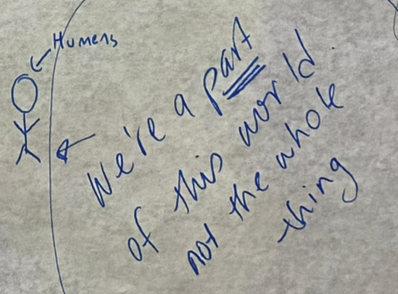
Finally, some community members were engaged asynchronously by providing video or email testimonials or feedback and/or responding via a feedback form designed by the event organizers. Nearly 100 stakeholders provided feedback in this way, including neighborhood residents, Indigenous community leaders, members of advocacy groups, staff of similar sites elsewhere in the Twin Cities, and elected officials.
When they were asked about how they are connected to the Boys Totem Town site, several participants acknowledged their history as part of the history of settler colonialism. Others appreciated the ways in which people and all living things are connected to this site. Finally, some had a personal connection to the Boys Totem Town juvenile detention facility.
When they were asked about how they are connected to the Boys Totem Town site, several participants acknowledged their history as part of the history of settler colonialism. Others appreciated the ways in which people and all living things are connected to this site. Finally, some had a personal connection to the Boys Totem Town juvenile detention facility.
I am connected [to this site] because we are all connected. Our histories intertwined.” |
I am a settler on stolen Dakota land, seeking to contribute to repair efforts, by following Dakota leadership.” |
My brother stayed at Boys Totem Town in the 60s. He now stays in a shelter and has mental health issues. Because of the way it was run this was not a safe place for him."
All of these sources of feedback from community stakeholders were synthesized and summarized in this report. An independent consultant, Dr. Nicole MartinRogers, was contracted to help design the facilitated activities at the event, to analyze the data gathered at the event, and to prepare this report.
Key findings: Community input about the Boys Totem Town site
At the event, participants were asked to engage in group activities to brainstorm the possible uses of the BTT site. Participants indicated their preferences for a variety of potential future uses of the Boys Totem Town site. One or more participants contributed to drawings that are shown throughout this report. The images participants drew or contributed to reflected themes of nature (oak trees), the interconnectedness of all living things, the Dakota history and approach to stewardship of the site, and protesting youth incarceration.
On the post-event feedback survey, community members were asked to write a comment about what they feel is the most important thing about the site and they were also asked what they imagine could happen at the site in the future. Their responses to both of these questions were analyzed using the same set of codes, because there was significant overlap in the themes that arose across these two questions. Giving the land back to the Dakota people was the most frequently offered suggestion. Creating a nature preserve, using the site in a way that reflects and honors the historical and cultural significance of the site, and creating a space to promote racial justice and healing are among other commonly offered ideas. Less commonly suggested ideas include using the site for affordable housing, a community center, a public park, and/or for camp or recreational and environmental education programs. A few participants suggested a community garden, farmers’ market, and a space for arts.
At the event, participants were asked to engage in group activities to brainstorm the possible uses of the BTT site. Participants indicated their preferences for a variety of potential future uses of the Boys Totem Town site. One or more participants contributed to drawings that are shown throughout this report. The images participants drew or contributed to reflected themes of nature (oak trees), the interconnectedness of all living things, the Dakota history and approach to stewardship of the site, and protesting youth incarceration.
On the post-event feedback survey, community members were asked to write a comment about what they feel is the most important thing about the site and they were also asked what they imagine could happen at the site in the future. Their responses to both of these questions were analyzed using the same set of codes, because there was significant overlap in the themes that arose across these two questions. Giving the land back to the Dakota people was the most frequently offered suggestion. Creating a nature preserve, using the site in a way that reflects and honors the historical and cultural significance of the site, and creating a space to promote racial justice and healing are among other commonly offered ideas. Less commonly suggested ideas include using the site for affordable housing, a community center, a public park, and/or for camp or recreational and environmental education programs. A few participants suggested a community garden, farmers’ market, and a space for arts.
This site has major cultural, historical, recreational, and ecological value. There is a largely undeveloped oak savanna ecosystem, within the Mississippi River Corridor Critical Area, consisting of thousands of native animals (some of which are listed as endangered), plant, and fungi species that depend on oak savannas for habitat.”
[I would like to see the site used for] outdoor education or camping experience for schools, families/ kids who are typically underrepresented in the State Park system.” |
The most important thing is that this is unceded Dakota homeland and it should be returned to them.” |
Table 1. Community members’ suggestions for how the Boys Totem Town site should be used
Theme |
Most important thing about the site |
What you want to see for the future of the site |
Total |
Land back to Dakotas |
49 |
61 |
110 |
Historical and cultural significance of the site |
27 |
12 |
39 |
Racial justice and healing |
13 |
26 |
39 |
Nature preserve, protect the oak savanna |
19 |
19 |
38 |
Affordable housing |
1 |
4 |
5 |
Community center or park |
-0- |
5 |
5 |
Environmental education |
2 |
2 |
4 |
Theater, sculpture garden, or public art space |
-0- |
3 |
3 |
Nature center, camp, recreation programs, community garden, farmer’s market |
-0- |
2 |
2 |
*Important note. This table shows the number of times various themes appeared in community members’ comments. One community member could have mentioned the same theme twice – once in each question.
“Given the archaeological significance of the land to Native people I would like to see the land returned and preserved... There have been few instances where Native land has been returned, and this should be one of those examples...” “I believe in the healing power of this ancient natural environment that has held our deepest sufferings, history, and memories. This land holds great opportunity for transforming our relationships with each other and the living beings that reside there now.” “The developed parts of the site should be used for mixed income housing, perhaps a community center, an interpretive kiosk explaining the history of BTT, and other uses that would promote equity and restorative justice. The undeveloped oak savanna and pond should be restored and protected as a park area with trails open to the public.” |
When they were asked at the event to pick from a list of predefined possible uses of the site and to group the things that would work well together, many participants matched up the idea of giving the land back to the Dakota people with the idea of using the site to support racial justice. Some also thought that it could work with a community center, garden, and/or public park. Other participants liked the idea of using the site for a combination of nature preserve, public park, environmental education, a camp or recreation program, and/or a theater or performance space. One participant matched up affordable housing with a community garden and community center.
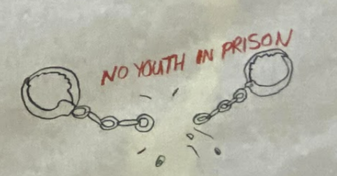
Conversely, when they were asked at the event what things they do not want the space used for the most common response was a juvenile detention center. However, one participant who completed the post-event survey does think a juvenile detention facility is needed in the community due to recent increases in juvenile violent crime. Four community members who completed the post-event survey said they do not want the site used for housing.
One participant who completed the post-event survey does not want the site used for commercial development. Another respondent indicated they do not want to give the land back to the Dakota people. Similarly, when they were asked at the event which ideas for the site wouldn’t work well together, many participants indicated that commercial or standard residential development would not fit well with a focus on racial justice, using the site as a nature preserve or park, and/or returning the land back to the Dakota people.
One participant who completed the post-event survey does not want the site used for commercial development. Another respondent indicated they do not want to give the land back to the Dakota people. Similarly, when they were asked at the event which ideas for the site wouldn’t work well together, many participants indicated that commercial or standard residential development would not fit well with a focus on racial justice, using the site as a nature preserve or park, and/or returning the land back to the Dakota people.
Finally, some participants wondered about the process of making decisions about the site and how the County and City will be involved.
“Is Ramsey County participating in this process? As owner of the land, it is critical that the County, and the City (responsible for planning and zoning of the site) are listening to the many voices and perspectives of neighbors, the Dakota community, who must be accepted as stakeholders in future decisions with the city and county.” |
How will different input be weighted in the decision-making process? How do you quantify the value of righting a centuries-old wrong?" |
Important considerations for Ramsey County
These considerations are offered by the event organizers after reviewing the results of community input that was summarized in this report.
These considerations are offered by the event organizers after reviewing the results of community input that was summarized in this report.
- The County and City should include key stakeholders, especially the Dakota community, immigrant communities, and those affected by incarceration at Boys Totem Town, in decision-making about the site.
- Participants in this process overwhelmingly want to give the land and decision-making authority over the land back to the Dakota people, and to consider their history and connection to the land.
- Efforts to engage with marginalized communities need to be deepened, and multiple points of access need to be provided and presented to those communities, especially immigrant communities. Providing opportunities like online feedback forms can radically change the participation of target communities, and bringing these options to places where communities gather would ensure our ability to consider the community’s desires.
- In particular, immigrant communities, like Hmong and Somali community members, and those impacted by the history of juvenile detention, need further and broader outreach in order to have their voices properly heard.
- Although a relatively small group of community members showed up for this early conversation about the future of the BTT site, there is active interest in staying updated and involved in creating a community-centered vision for this land.
- Participatory, kind, and community-centered engagement can ease traditionally divisive or corrosive rhetoric and behavior in engaging around difficult issues.
- The site presents opportunities to promote racial and environmental justice and healing.
- There is ecological importance and value to preserving the oak savanna on the site.
As one participant stated:
Thank you for asking for this input from the residents of Ramsey County!”
Resource List
- The Event Website: https://www.bttccc.org/
- The Slides From The Event: https://docs.google.com/presentation/d/1LtSwFNK1ttYhLuvBz3KnbUir-37wyZ3gn3kMVrreY4Q/e
dit?usp=sharing - The Video From The Event: https://www.youtube.com/watch?v=87Yj8ZCuSkQ&t=5s
- The Online Feedback Form Results:
https://docs.google.com/spreadsheets/d/1l4PGMR8AX9sw8Q-LaoXS6zMjp77wk3c2I9K3Jxxnup4
/edit?usp=sharing
